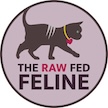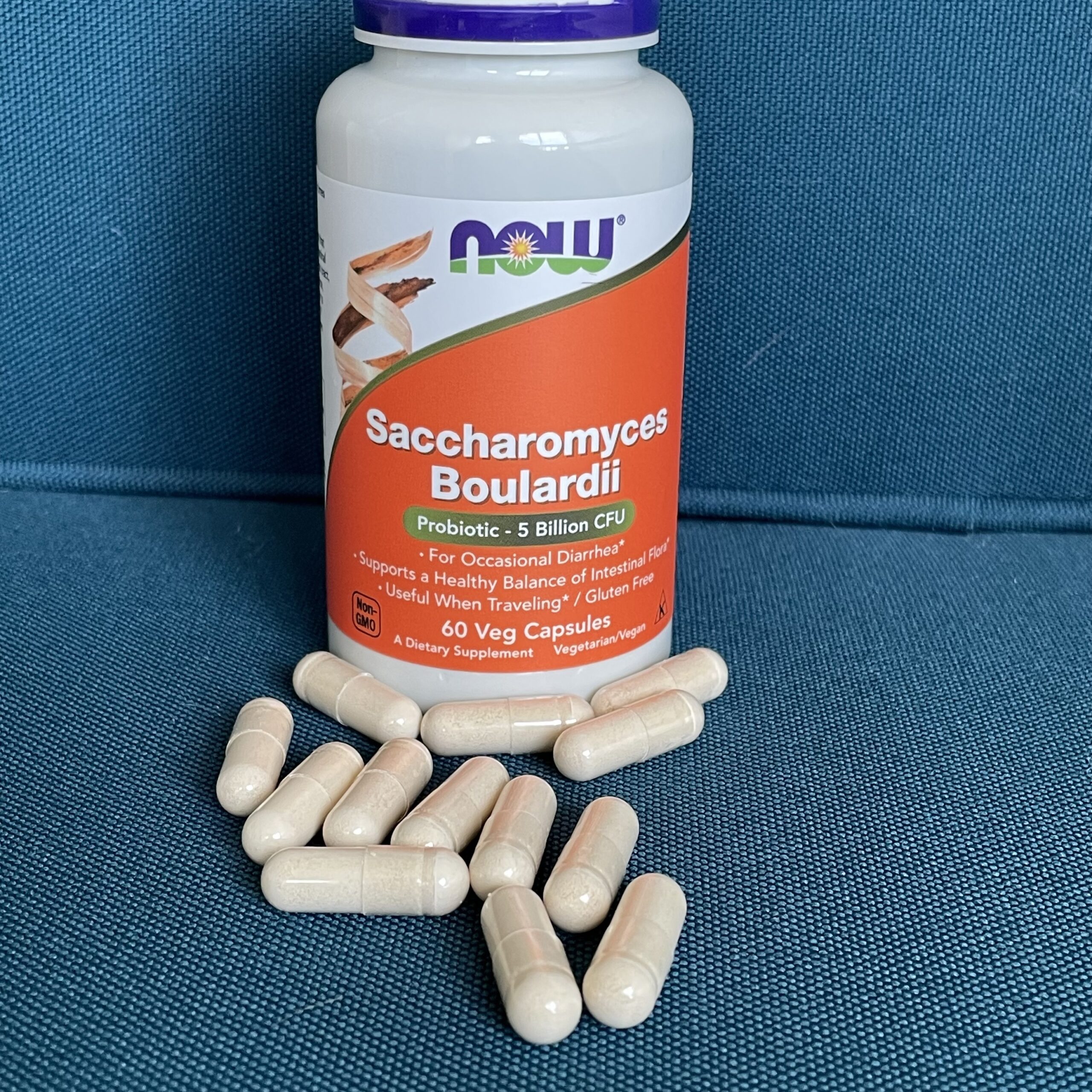Let’s take a look at the benefits of S boulardii in healthy cats, what makes it so magical, and why you might want to consider adding it to support your cat’s gut microbiome.
The gut microbiome
The gut microbiome refers to the population of microorganisms in the gut, including good and bad bacteria. In a healthy animal, the good bacteria outnumber the bad. The specific kinds of bacteria present are influenced by the diet as well as lifestyle, age, and health.
One of the best ways to support gut health is to feed a varied, species appropriate diet. The food eaten influences which bacteria proliferate in the gut. If you only feed one or two foods/proteins, then those related bacteria will be more plentiful. If you feed a more varied diet, there will be more different kinds of bacteria, which strengthens the overall system.
So the first line of defense regarding gut health and the overall immune system is to feed a varied, biologically appropriate diet. What about pre/probiotics and how does S boulardii figure in?
Pre and probiotics
Pre and probiotics can be an important way to support the gut microbiome. I wrote about what to look for in pre/probiotics here.
Probiotics are actual living microorganisms, aka the “good bacteria.” They populate and colonize in the gut. When the gut has more good bacteria than bad, the immune system functions well. This promotes a state of health for the animal.
Prebiotics are the food for the probiotics. They are technically non-digestible carbohydrates, specifically oligosaccharides. The most common prebiotics that you will see in supplements are MOS, FOS, and Larch.
points of view on pre/probiotic usage
There have been two general points of view about pre/probiotics in the raw feeding community.
One point of view is that they should only be given for a specific reason. Pre/probiotics are only needed to support the gut if your cat has had antibiotics or during the transition to new foods. But in general, it is thought that a diverse and varied diet is enough to support gut health without the need for ongoing pre/probiotics in otherwise healthy cats. The concern is that giving pre/probiotics without cause can be “too much of a good thing.”
The other point of view is that less nutritious food, constant exposure to chemicals, less exposure to soil and its microbes, etc., are constants in our cats’ lives. Pre/probiotics are encouraged to be given on a regular basis to account for these issues. It is encouraged to rotate several brands to promote diversity.
(Of course, if your cat struggles with chronic digestive issues, IBS/IBD, etc. that will need a specialized approach regarding pre/probiotics.)
S boulardii
However, there is recent research about S boulardii that is important to consider in the conversation about what might be helpful for ongoing gut support for healthy cats. So let’s dive in!
S boulardii is different from bacteria based probiotics in that it is a yeast. It does not colonize or repopulate in the gut. It will not alter the microbiome in the same way as bacteria based probiotics. This helps alleviate the concern about giving “too much of a good thing.”
S boulardii helps in other important ways: “Saccharomyces boulardii exhibits distinct probiotic properties, including improved intestinal barrier function, competitive exclusion of pathogens, production of antimicrobial peptides, and immunomodulatory and nutritional effects.”
The police of the gut
There is ample evidence that S boulardii is helpful in reducing diarrhea for people and animals. But it also acts proactively as the “police of the gut” for healthy cats, too. It “protects and serves” the gut by decreasing the amount of bad bacteria, especially E. coli and C. perfringens. S boulardii prevents the proliferation of and/or removes pathogenic bacteria. It also helps strengthen the walls and lining of the intestines, aka defends against leaky gut.
Some newer raw feeders and those cat parents who are not yet sure about feeding raw, often cite their concerns regarding bacteria and their cat getting sick. S boulardii (along with feeding quality raw foods and practicing good hygiene) should help alleviate concerns of healthy cats getting sick by its supportive and protective actions in the gut.
“It was concluded that in healthy adult cats, consumption of YCW modulates the faecal bacterial populations, with an increased presence of beneficial bacteria and a reduction in some potentially pathogenic bacteria.” (YCW referring to yeast cell wall)
Other important benefits
S boulardii has been shown to “improve short chain fatty acid production, reduce inflammation, and increase antioxidants in healthy cats.” All of which significantly contribute to our cats’ overall well being and health.
Short chain fatty acids (SCFAs) are particularly important when it comes to gut health. “SCFAs have been shown to alter chemotaxis and phagocytosis; induce reactive oxygen species (ROS); change cell proliferation and function; have anti-inflammatory, antitumorigenic, and antimicrobial effects; and alter gut integrity. These findings highlight the role of SCFAs as a major player in maintenance of gut and immune homeostasis.“
There has also been research indicating that S boulardii may be helpful in lowering glycemic levels in obese dogs. More research is needed to fully understand the specific ramifications for cats, but these are exciting potential benefits for cats as well.
Stress and mental health
Additionally, S boulardii has been studied to understand its impact on companion animals’ mental health and well being. In this study with healthy dogs, the authors looked at the impact on the dogs’ stress levels, as evidenced by the amount of cortisol. The dogs given S boulardii showed a statistically significant difference in cortisol levels, suggesting that it can be a helpful component in mitigating pets’ stress.
We have brought apex predators into our homes. Many indoor cats live in chronically under stimulating environments. Chronic under stimulation can be highly stressful, lowers immune function, and leads to depression in cats. Additionally, many cats struggle with anxiety given their high sensitivity to their environments.
I think this study offers important food for thought regarding the inclusion of S boulardii as a helpful component of an overall stress management plan for indoor cats, highly anxious cats, and cats in shelter and rescue situations.
S boulardii survives the acidic environment
It’s important to note that S boulardii is capable of withstanding the highly acidic stomach of our cats and remains viable as it travels through the digestive system: “Saccharomyces boulardii is physiologically and metabolically tolerant to low pH levels and resistant to the gastric environment.”
This is very good news given concerns about how effectively bacteria based probiotics reach the intestines, especially when given with food. But thankfully, you can give S boulardii with food, which makes it very easy to administer.
Since researching this topic, I sprinkle ~1/4 of a 250mg (5 billion CFU) capsule once daily on one of Hazel’s meals for supportive maintenance. (For reference, the starting therapeutic dose of S boulardii for diarrhea in adult cats is 1/2 capsule, twice daily.)

S boulardii is magical
In sum, S boulardii is a yeast that survives the highly acidic stomach and digestive tract. It does not alter the microbiome through proliferation or colonization, but helps modulate the microbiome through removal of pathogenic bacteria. It also strengthens the intestinal wall lining.
S boulardii supports short chain fatty acid production, is anti-inflammatory, and has anti-oxidant properties. It reduces cortisol levels as related to stress. All of these statistically significant benefits were studied in otherwise healthy dogs and cats.
You can see why I refer to S boulardii as magical with all of these benefits! So, if you want an inexpensive way to support your healthy cat’s gut and overall immunity, you may want to add S boulardii. Bonus–you can easily find it at local vitamin shops and online.



2 responses to “The Magic of S Boulardii”
I’m planning to deworm my 2 cats. both are raw fed, and are mostly outdoor cats and they catch rodents. I rarely deworm them, last time I did it when they were kittens, and now they’re little over 1 year old. should I give them s boulardii after they’ve been dewormed to support their gut microbiome? 🙂
It may depend on which dewormer used as to the impact on the gut microbiome. If wanting to repopulate the gut, a bacteria based probiotic that also contains S boulardii would be better than S boulardii alone. Nexabiotic is a good option.
https://pubmed.ncbi.nlm.nih.gov/966708/